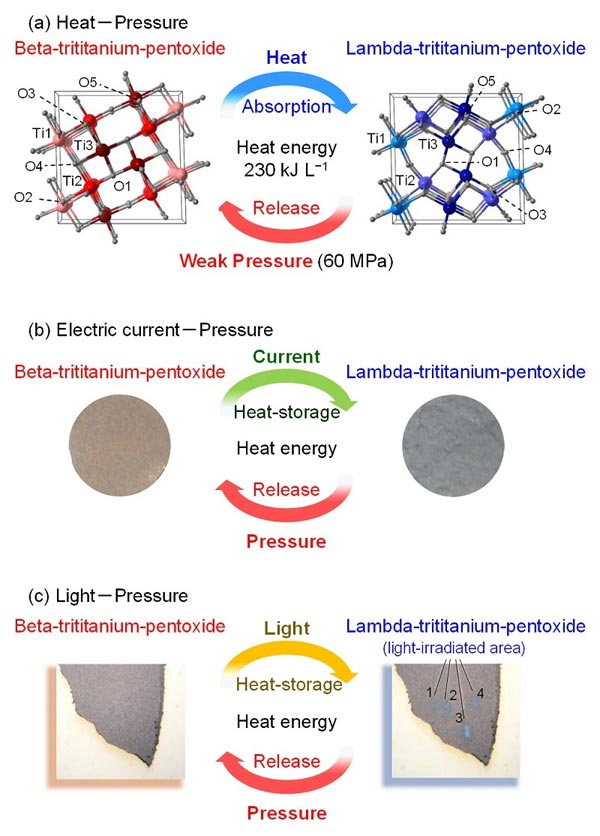Discovery of a "heat-storage ceramic"

A novel “heat-storage ceramic” demonstrated in stripe-type-lambda-trititanium-pentoxide. (a) The material stores heat energy of 230 kJ L-1 by heating and releases the energy by a weak pressure (60 MPa). In addition, this material stores heat energy by various approaches such as (b) electric current flow or (c) light-irradiation. © 2015 Shin-ichi Ohkoshi.
Researchers at the University of Tokyo have discovered a new type of material which stores heat energy for a prolonged period, which they have termed a “heat storage ceramic.”
This new material can be used as heat storage material for solar heat energy generation systems or efficient use of industrial heat waste, enabling recycling of heat energy, since the material releases the stored heat energy on demand by application of weak pressure.
Materials capable of storing heat include those such as bricks or concrete that slowly release the stored heat, and others such as water or ethylene glycol that take in heat when they transform from a solid to a liquid. However, none of these materials can store heat energy over a long period as they naturally release it slowly over time. A material that could store heat energy for a long time and release it at the exact timing desired would be a boon for the field of renewable energy.
The heat storage ceramic discovered by the research group of Professor Ohkoshi at the University of Tokyo Graduate School of Science preserves heat energy for a prolonged period. This material, called stripe-type-lambda-trititanium-pentoxide, is composed of only titanium atoms and oxygen atoms, and can absorb and release a large amount of heat energy (230 kJ L-1).
This heat energy stored is large at approximately 70% of the latent heat energy of water at its melting point. Additionally, applying a weak pressure of 60 MPa (mega Pascal) to stripe-type-lambda-trititanium-pentoxide induces a phase transition to beta-trititanium-pentoxide, releasing the stored heat energy.
Besides direct application of heat, heat energy can be stored by passing an electric current through the material or irradiating it with light, enabling the repeated absorption and release of heat energy by a variety of methods.
Stripe-type-lambda-trititanium-pentoxide is a simple titanium oxide composed of abundant elements and is environmentally friendly. The present heat-storage ceramic is expected to be a new candidate for use in solar heat power generation systems, which are actively promoted nowadays by European countries, and also for efficient use of industrial heat waste.
This material also has possibilities for use for advanced electronic devices such as pressure-sensitive sheets, reusable heating pads, pressure-sensitive conductivity sensors, electric current driven type resistance random access memory (ReRAM), and optical memory.
Paper
H. Tokoro, M. Yoshikiyo, K. Imoto, A. Namai, T. Nasu, K. Nakagawa, N. Ozaki, F. Hakoe, K. Tanaka, K. Chiba, R. Makiura, K. Prassides, and S. Ohkoshi, “External stimulation-controllable heat-storage ceramics”, Nature Communications 6, Article number:7037, 2015, doi: 10.1038/ncomms8037.
Associated links
UTokyo Research article
Media Contact
All latest news from the category: Materials Sciences
Materials management deals with the research, development, manufacturing and processing of raw and industrial materials. Key aspects here are biological and medical issues, which play an increasingly important role in this field.
innovations-report offers in-depth articles related to the development and application of materials and the structure and properties of new materials.
Newest articles

An Endless Loop: How Some Bacteria Evolve Along With the Seasons
The longest natural metagenome time series ever collected, with microbes, reveals a startling evolutionary pattern on repeat. A Microbial “Groundhog Year” in Lake Mendota Like Bill Murray in the movie…

Witness Groundbreaking Research on Achilles Tendon Recovery
Achilles tendon injuries are common but challenging to monitor during recovery due to the limitations of current imaging techniques. Researchers, led by Associate Professor Zeng Nan from the International Graduate…

Why Prevention Is Better Than Cure—A Novel Approach to Infectious Disease Outbreaks
Researchers have come up with a new way to identify more infectious variants of viruses or bacteria that start spreading in humans – including those causing flu, COVID, whooping cough…



